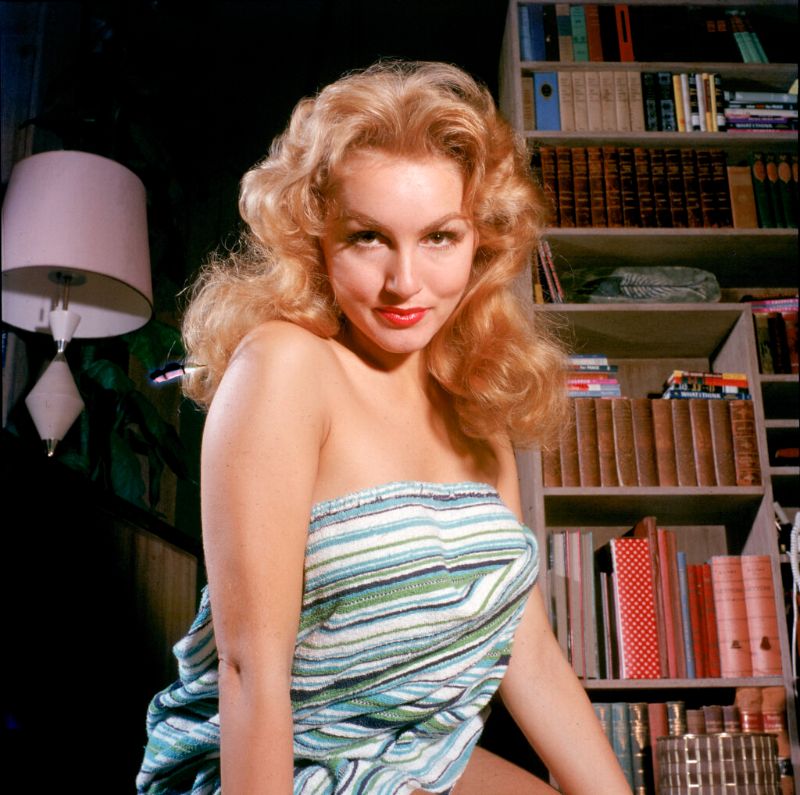Long before superhero franchises dominated the screens, there was one woman who transformed a feline villainess into a pop culture icon—Julie Newmar. With her statuesque frame, hypnotic voice, and razor-sharp wit, Julie wasn’t just playing Catwoman; she was Catwoman. But behind the mask, the purr, and the claws was a woman whose journey through Hollywood, business, and life was as bold, fascinating, and multifaceted as any role she ever played.
Born Julia Chalene Newmeyer on August 16, 1933, in Los Angeles, California, Julie was raised in a household that valued intellect and artistry. Her mother was a fashion designer, her father a football star who later became a college professor. From him, she inherited discipline and sharp intelligence; from her mother, a sense of elegance and style. It was a combination that would serve her well in the spotlight.
Even as a child, Julie showed remarkable promise. She excelled academically and immersed herself in the arts, proving herself as more than a pretty face long before Hollywood noticed her. Ballet became her first true calling, and as a teenager she danced with the Los Angeles Opera. Her extraordinary grace, poise, and natural sense of drama were evident even then. She also studied piano, philosophy, and French at UCLA before moving to New York to pursue her artistic ambitions further. At the School of American Ballet, her training deepened, and her long, athletic figure—six feet tall with the posture of a dancer—made her stand out.

The stage soon beckoned. On Broadway, she appeared in George Balanchine’s Silk Stockings before landing the role that first made her famous: Stupefyin’ Jones in Li’l Abner. Her brief appearance as the impossibly alluring character—so stunning that men on stage literally froze in their tracks—made audiences laugh and left an indelible impression. Julie’s ability to mix comedy with glamour would become one of her hallmarks.
Hollywood quickly came calling. Though her earliest roles were uncredited parts in musicals like Just for You (1952) and Seven Brides for Seven Brothers (1954), she stood out on screen. With her towering height, expressive eyes, and dancer’s grace, she didn’t merely appear in a scene; she commanded it. The 1950s saw her slowly but steadily transition from background dancer to recognizable actress.

Yet it was television, more than film, that gave Julie her most enduring legacy. In 1966, she stepped into the role of Catwoman on ABC’s campy Batman series opposite Adam West. In that sleek black catsuit, Julie purred, prowled, and teased her way into television history. She redefined the character into something witty, playful, and irresistibly dangerous. Catwoman, under Newmar’s spell, wasn’t just a criminal foil—she was an empowered, intelligent adversary who could outsmart Batman as often as she tried to seduce him.
Julie’s Catwoman became the blueprint for every future portrayal, from Michelle Pfeiffer to Anne Hathaway to Zoë Kravitz. She embodied contradictions that made the character timeless: both villain and vixen, comedic and menacing, larger-than-life yet oddly relatable. Decades later, Julie Newmar’s Catwoman remains one of the most celebrated female characters of 1960s television, proof that her charisma could turn a gimmick into a cultural icon.

Her work, however, extended far beyond Gotham. Julie starred in her own sitcom, My Living Doll (1964–65), playing Rhoda, a highly intelligent android learning to live as a human woman. Though the show was short-lived, it allowed Newmar to flex her comedic skills and charm audiences weekly. She made guest appearances on
The Twilight Zone, Bewitched, Star Trek, and Route 66, proving her versatility across genres. On the big screen, she appeared in films such as The Marriage-Go-Round
(1961), which earned her a Golden Globe for Most Promising Newcomer.
But Julie Newmar’s ambitions were never confined to the screen. She had a sharp business mind and a love for design, especially architecture and gardening. While many Hollywood contemporaries struggled financially, Julie invested wisely, buying and restoring properties in West Hollywood. She was known for creating lush gardens and preserving the beauty of historic homes. In her eyes, designing a beautiful space was as much an artistic pursuit as embodying a character.

Her personal life also reflected her complexity. In 1981, she gave birth to her son, John Jewl Smith, who was born with Down syndrome. Julie embraced motherhood with the same grace she brought to her career, fiercely protective of her son and deeply devoted to his happiness. She often spoke of him as her greatest joy.
In 2003, Julie revealed that she had been diagnosed with Charcot-Marie-Tooth disease, a neurological condition that affects muscle control. Rather than hide, she became an advocate, raising awareness and continuing to live vibrantly. Her resilience mirrored the fearless confidence of her most famous roles.
She also turned to writing. In 2011, she published The Conscious Catwoman Explains Life on Earth, a memoir filled with musings on love, beauty, aging, and individuality. The book reflected her wit, wisdom, and refusal to conform to Hollywood clichés. Julie celebrated uniqueness and encouraged others to embrace their quirks, much as she had done throughout her career.

Even pop culture continued to honor her. In 1995, the cult film To Wong Foo, Thanks for Everything! Julie Newmar immortalized her name in its title, recognizing her status as a queer icon and a symbol of enduring glamour. Julie herself made a cameo, a reminder that she had long embraced her role as a cultural touchstone for individuality and self-expression.
Today, Julie Newmar is remembered not only as the definitive Catwoman but also as a woman who lived life on her own terms. She is a dancer, an actress, a comedian, a businesswoman, a mother, and an advocate. Her legacy spans from Broadway stages to Hollywood studios, from television’s rooftops of Gotham to the flowering gardens she cultivated in California.

Julie Newmar showed the world that a woman could be both fierce and graceful, both playful and profound. She embodied fantasy on screen while living authentically off it. Few performers have played as many roles in life as she has—and even fewer have done so with such fearless elegance.


